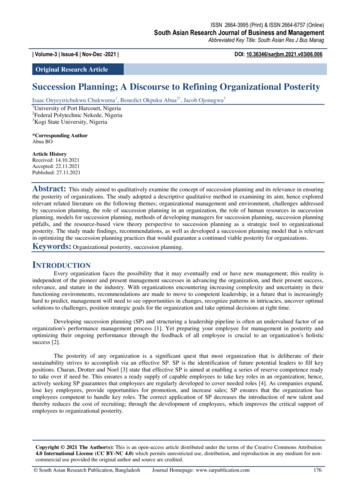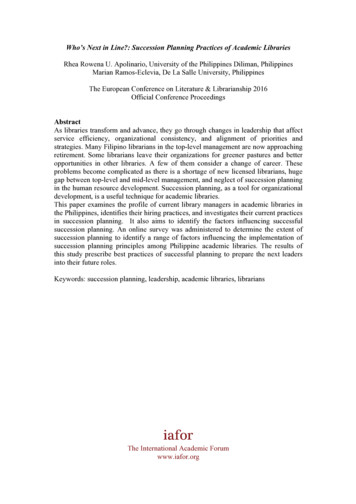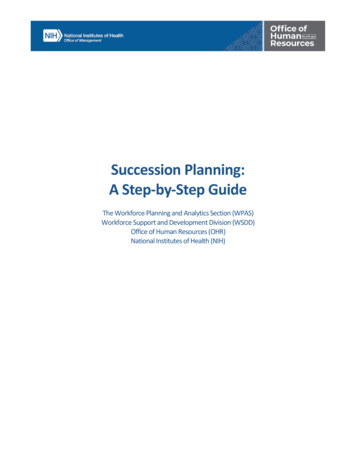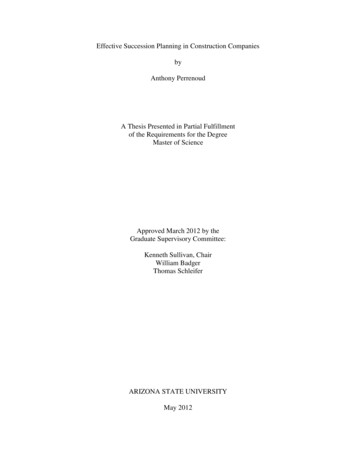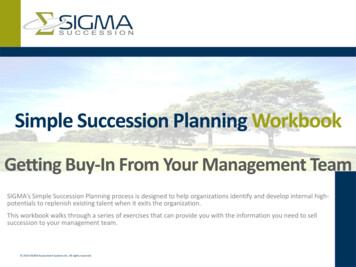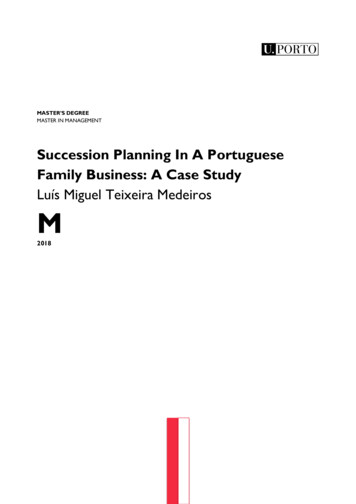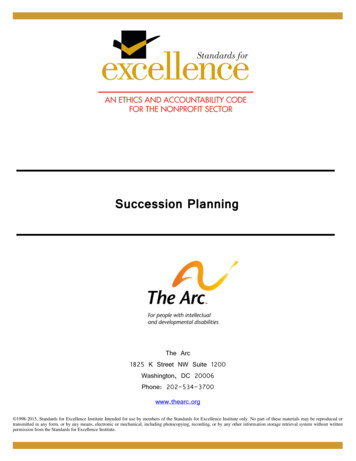
Transcription
Succession PlanningThe Arc1825 K Street NW Suite 1200Washington, DC 20006Phone: 202-534-3700www.thearc.org 1998-2015, Standards for Excellence Institute Intended for use by members of the Standards for Excellence Institute only. No part of these materials may be reproduced ortransmitted in any form, or by any means, electronic or mechanical, including photocopying, recording, or by any other information storage retrieval system without writtenpermission from the Standards for Excellence Institute.1
PREAMBLEAmerica’s nonprofit sector serves the public interest and plays an essential role in our society and economy. Hardat work strengthening communities across the nation, nonprofits enrich our lives in a variety of ways by creatinga broad array of benefits to society in fields such as charitable, religious, scientific, economic, health, cultural,civil rights, environment, and education.Public investment and confidence drive the success of nonprofit organizations. Individuals, corporations,foundations, and federal, state, and local governments add value to the services that nonprofits provide byinvesting time, resources, and funds.The Standards for Excellence Institute aims to raise the level of accountability, transparency, and effectiveness ofall nonprofit organizations to foster excellence and inspire trust. The Standards for Excellence code (Standards,or code) provides a framework and step-by-step guidelines to achieve a well-managed and responsibly governedorganization.The code builds upon the legal foundations of nonprofit management, governance, and operations to embracefundamental values such as honesty, integrity, fairness, respect, trust, compassion, responsibility, andtransparency. The code consists of six Guiding Principles in 27 topic areas with specific performancebenchmarks that characterize effective, ethical, and accountable organizations. The Institute helps the nonprofitsector operate in accordance with the Standards for Excellence code by providing educational resources,assistance, and a voluntary accreditation process.The Standards for Excellence Institute encourages all nonprofit organizations to adopt the Guiding Principles ofthe Standards for Excellence code. By implementing the performance benchmarks in the code, nonprofitorganizations will meet the highest ethical standards for effective service in the public interest.STANDARDS FOR EXCELLENCE - GUIDING PRINCIPLESI.MISSION, STRATEGY and EVALUATIONGuiding Principle: Nonprofits are founded for the public good and operate to accomplish a stated purpose throughspecific program activities. A nonprofit should have a well-defined mission, and its programs should effectivelyand efficiently work toward achieving that mission. Nonprofits have an obligation to ensure programeffectiveness and to devote the resources of the organization to achieving its stated purpose.II.LEADERSHIP: BOARD, STAFF, and VOLUNTEERSGuiding Principle: Nonprofits depend upon effective leadership to successfully enact their missions andprograms. Effective leadership consists of a partnership between the board and management, each of which playsan essential role. Understanding and negotiating these shared and complex elements of leadership is essential tothe organization’s success. A nonprofit's employees and volunteers are fundamental to its ability to achieve itsmission.Board members are in a position of trust to ensure that resources are used to carry out the mission of theorganization. An organization’s board leadership should consist of volunteers who are committed to the missionand who demonstrate an understanding of the community served. An effective nonprofit board should determinethe mission of the organization, establish management policies and procedures, assure that adequate human andfinancial resources are available, and actively monitor the organization's allocation of resources to effectively andefficiently fulfill its mission.Nonprofits should also have executive leadership which carries out the day-to-day operations of the organization,ensures financial and organizational sustainability, and provides adequate information to the board of directors.An organization's human resource policies should address both paid employees and volunteers and should be fair,establish clear expectations, and provide meaningful and effective performance evaluation.2
III.LEGAL COMPLIANCE and ETHICSGuiding Principle: Nonprofits enjoy the public’s trust, and therefore must comply with a diverse array of legaland regulatory requirements. Organizations should conduct periodic reviews to address regulatory and fiduciaryconcerns. One of a leadership’s fundamental responsibilities is to ensure that the organization governs andoperates in an ethical and legal manner. Fostering exemplary conduct is one of the most effective means ofdeveloping internal and external trust as well as preventing misconduct. Moreover, to honor the trust that thepublic has given them, nonprofits have an obligation to go beyond legal requirements and embrace the highestethical practices. Nonprofit board, staff, and volunteers must act in the best interest of the organization, ratherthan in furtherance of personal interests or the interests of third parties. A nonprofit should have policies in place,and should routinely and systematically implement those policies, to prevent actual, potential, or perceivedconflicts of interest. Ethics and compliance reinforce each other.IV.FINANCE AND OPERATIONSGuiding Principle: Nonprofits should have sound financial and operational systems in place and should ensurethat accurate records are kept. The organization's financial and nonfinancial resources must be used in furtheranceof tax-exempt purposes. Organizations should conduct periodic reviews to address accuracy and transparency offinancial and operational reporting, and safeguards to protect the integrity of the reporting systems.V.RESOURCE DEVELOPMENTGuiding Principle: The responsibility for resource development is shared by the board and staff. Nonprofitorganizations depend on an array of sources of financial support. An organization's resource developmentprogram should be maintained on a foundation of truthfulness and responsible stewardship. Its resourcedevelopment policies should be consistent with its mission, compatible with its organizational capacity, andrespectful of the interests of donors, prospective donors, and others providing resources to the organization.VI.PUBLIC AWARENESS, ENGAGEMENT, and ADVOCACYGuiding Principle: Nonprofits should represent the interests of the people they serve through public education andpublic policy advocacy, as well as by encouraging board members, staff, volunteers, and stakeholders toparticipate in the public affairs of the community. When appropriate to advance the organization’s mission,nonprofits should engage in promoting public participation in community affairs and elections. As such, theyshould communicate in an effective manner to educate, inform, and engage the public.ABOUT THE STANDARDS FOR EXCELLENCE INSTITUTEThe Standards for Excellence Institute is a national initiative established to promote the highest standards ofethics and accountability in nonprofit governance, management and operations, and to facilitate adherence tothose standards by all nonprofit organizations. The Institute uses as a vehicle the Standards for Excellenceprogram, a system of nonprofit sector industry self-regulation originated by the Maryland Association ofNonprofit Organizations and currently replicated by licensed partners in Alabama, Central Virginia, ColoradoSprings, Delaware, Ohio, Oklahoma, and Pennsylvania. The program is also being offered to chapters of The Arcnationwide through The Arc of the United States, to the American Nurses Association, and to Catholic nonprofitorganizations nationwide through the National Leadership Roundtable on Church Management.The centerpiece of the Institute’s program is the Standards for Excellence: An Ethics and Accountability Code forthe Nonprofit Sector. The Institute also makes available to member organizations a comprehensive system ofeducational tools to enable individual nonprofit organizations to improve their governance and managementpractices. Standards for Excellence accreditation is available to individual organizations through a rigorous peerreview process in selected locations and nationwide through the Standards for Excellence Institute.For more information about joining the Standards for Excellence Institute or to obtain additional copies of thebooklet or educational resource packets visit our website at .3
SUCCESSION PLANNINGAs the Standards for Excellence: An Ethics and Accountability Code for the Nonprofit Sectorstates:The board, in partnership with the executive, should engage in coordinated succession planningand leadership development to ensure a thorough process for recruiting and developing newboard, executive, staff, and volunteer leaders.The numbers are staggering. Nonprofit organizations need to be prepared for leadership1transition in their ranks. A recent nation-wide study on nonprofit leadership showed that twothirds of all executive directors expect to leave their positions within a five year window.2Nonprofit organizations that have been shielded, thus far, from transition in the executivedirector position may soon find themselves facing the issue head on.Succession planning not only can ensure continuity and reliability during transitions ofleadership at board, executive, and key staff levels, but also can strengthen an organization’scurrent operations and structure. This educational resource packet provides an overview oftypes of succession planning, the importance of leadership development, key elements ofsuccession plans and procedures, and tips on succession planning.Staff Departure-Defined Succession Planning vs. Emergency Succession Planning3Departure-defined succession planning occurs when a key leader identifies an exit date two tofive years in advance of his or her departure. Departure-defined succession plans usuallyconsists of specific, detailed steps for organizational leadership to take during a defined periodleading up to the leader’s departure. By contrast, emergency succession planning occurs whenkey organizational leadership leaves his or her post unexpectedly.Regardless of the type of succession planning required, there are concrete steps that anynonprofit organization can take now to ensure a smooth and high-quality leadership transition.1Nonprofit organizations use many different terms to describe their chief staff person. For the purposes of thisStandards for Excellence educational resource packet, we will use the term CEO, Executive, and executivedirector interchangeably. Nonprofits should refer to their bylaws and position descriptions for the termsestablished for use in their own organization2“Daring to Lead 2011: A National Study of Nonprofit Executive Leadership” is available free athttp://www.daringtolead.org.3While this educational resource packet focuses on the staff transitions for the position of the executive directoror key staff leader in an organization, it is also important to consider succession planning for other key staffpositions, such as the Chief Financial Officer, the Development Director, and the Program Director. Many of thesame transition concerns and steps (documentation of work strategy for interim staffing, cross-training) should bein place for these key staff positions, but the supervision of these positions would be a staff person, rather than theboard of directors.4
In fact, we recommend that all nonprofits, regardless of their size, put into place a successionplan even before they hire their first executive director. The plan need not be extensive, but itshould outline a general process for how the Board will address either planned or unplanneddepartures.Preparing for Succession: Leadership DevelopmentNonprofit organizations should provide ongoing professional development and leadershiptraining opportunities to staff. These opportunities could include leadership training,mentorships by more senior organizational leaders, providing employees with new andchallenging responsibilities, etc. By growing leaders internally, nonprofit organizations canensure that staff members are capable and prepared to manage the ongoing operations of theorganization during a leadership transition. In addition, building internal leadership canstrengthen the pool of internal candidates for the position that becomes available following aleadership transition. Nonprofit leaders should be cautioned to avoid making their entiresuccession plan dependent upon the organization’s internal candidates stepping into theexecutive director position. Time and time again, nonprofits depend upon this strategy only tofind that the pre-selected successor does not want to consider the position or ends up departingand becoming an executive director in another agency, prior to the carefully planned outsuccession that the board envisioned occurring so seamlessly.The Bridgespan Group provides a useful resource for planning and implementing leadershipdevelopment activities in their guide, “Nonprofit Leadership Development: What’s Your ‘PlanA’ for Growing Future opment-Guide.pdfDeveloping Succession Plans and ProceduresAs mentioned briefly above, the time to develop a succession plan is not upon the resignationor termination of your organization’s leadership. Develop a plan now and have it firmly inplace before the need arises.Nonprofit organizations should take the following steps into consideration when developing aformal succession plan:1) Identify Roles and Responsibilities. Nonprofits should determine who within theorganization is responsible for managing the transition process, as well as the roles andresponsibilities of each involved party.For guidance on the board’s role in executive leadership transition, see Maryland Nonprofits’“The Role of the Board in Executive utive-transition2) Conduct an Organizational Assessment. Organizational leadership should review theorganization’s strategy, strengths and weaknesses, and projected challenges and opportunitiesto frame conversations around leadership current needs. Remember to keep in mind that your5
needs may have shifted since you hired your last executive director. Conducting an assessmentwill allow the search team to understand the type of leader the organization needs, as well asareas which require particular attention during a transition (for example, when the individualleaving plays a significant role in resource development, administration of a particularprogram, etc.).3) Review Financial Resources and Funding Strategies. The leadership transition team shouldreview the organization’s financial position and strategies to determine whether adjustmentsare needed in preparation for the leadership transition (for instance, whether the organizationwill need to build new relationships between internal staff and funders, or explore new sourcesof revenue).4) Ensure that Organizational Knowledge is Accessible. The departing leader should ensurethat his or her organizational knowledge (including, relationships with partners and funders,the status of ongoing projects, etc.) is readily accessible to staff members and new leadership.Interim directors (see discussion below) should keep detailed records of changes that haveoccurred since the departure of the previous leader.5) Develop a Communications Plan. The leadership transition team should determine howthey will communicate to external audiences about the leadership transition, as well as whomthey will inform and at which stages. For more information on this topic, please see theStandards for Excellence educational resource packet on Communications, Engaging thePublic and Social Media.For examples, see the Sample Succession Plans section of the Selected Resources providedbelow.Hiring a New Executive DirectorIdentify an Interim Director. Interim leadership is key to effective succession, especially incases of emergency leadership transitions. The organization should determine in advance howit will select and onboard an interim director in the event of a departure-defined or emergencysuccession. Do not rely on the board chair to fill this role. He or she will be consumed withdetails of the transition and eventual succession. The Bridgespan Group provides a usefulresource on identifying interim leadership, “Interim Leadership: Looking Beyond theExecutive Director” ng-Beyond-ED.aspxIdentify, Evaluate, and Select Candidates. Organizations need to create well-defined plans forhiring executive leadership during both departure-defined and emergency transitions.Executive leadership and the board of directors should develop a formal process for evaluatinginternal and external candidates before the candidate selection process begins.The process should include clear standards for: position descriptions selection criteria6
roles of senior leadership and board membersexternal resources to be used (such as, executive directors from non-competingorganizations)Western Michigan University provides a useful sample hiring checklist for internal andexternal candidates: .pdf. In addition,Montana State University Billings provides a helpful reference on the advantages anddisadvantages of internal and external recruiting in “Pros and Cons of Internal and ExternalRecruiting” hiring.pdfFor more information on hiring internal and external candidates, see the Selected Resourcessection below.Succession Planning for Board LeadershipNot only do nonprofit organizations need to prepare for transitions and succession planning inthe executive director position, but in our world of term-limited boards, we also must be readyfor succession planning for board leadership on a more frequent basis.The board should ensure that it has a plan to fill key board leadership positions in the case ofboth planned and unplanned departures of officers of the board and committee leaders, toname a few. The mark of an exceptional leader is that his/her undertakings thrive and do notlose momentum or collapse in his or her absence. If you want competent people to be willingto step forward to take on leadership roles and continue efforts and initiatives, sitting boardleaders need to think about succession well before they plan to leave their posts.As your organization maintains an executive succession plan at all times, so too should yourboard. This holds true for committee chairs, project leaders, four-term board presidents, andalso for board members who do their work behind the scenes. Organizations can get the rightpeople to step into leadership roles if they are set up to succeed.Executive directors and boards of directors face unique challenges when transitioning boardmembers. To strengthen the board succession process, nonprofit organizations should makesure that: the work of board members is well documented – both through meeting minutes andthrough a written job description for board members in general and the board officers. they clearly identify the qualities and talents of ideal board members (such as, whatskills and leadership traits are required for a position on the board finance, program orfundraising committee?) Look beyond developing the standard board matrix thatqualifies potential members based on their professional abilities. Identify personalqualities that are important to your board such as integrity, curiosity, and commitment,for example. they continuously focus on how to attract high-quality board members (for example,conducting the board member search across diverse communities, capitalizing on theorganization’s exceptional culture or reputation, etc.). they start looking for and cultivating leadership before it is needed.7
In addition, nonprofit organizations should clarify the roles and responsibilities of boardmembers and other senior leadership in board succession planning. Nonprofits shouldformalize the position(s) or board committee responsible for: leading succession planning; identifying potential board members; and interviewing, evaluating and selecting candidates.The organization also should have a process for electing board members, which should beformalized in the organization’s bylaws.The Annie E. Casey Foundation provides a guide to board engagement in succession planningfor leadership transitions of both executive directors and board s/staying%20engaged,%20stepping%20up.pdfThe River Network provides a checklist and template for use in board succession planningentitled: ccessionPlan.pdfAlso see other Standards for Excellence educational resource packets on board related topicsfor more information.A special Board Room Quick Tip on this subject is provided as an attachment to thiseducational resource packet.Selected Resources on Succession PlanningGeneral Succession Planning Overviews“A Chief Executive Succession Planning Checklist,” /res/10/original/A CHIEF EXECUTIVE SUCCESSION PLANNING CHECKLIST.pdf“Building Leaderful Organizations,” Annie E. Casey Foundationhttp://www.aecf.org/ ns.pdf“Departure-Defined Succession Planning: The Seven Essential Elements for a Successful CEOTransition,” CompassPoint Nonprofit planning%20-%20final 0.pdf“Nonprofit Executive Succession-Planning Toolkit,” Federal Reserve Bank of Kansas df“Sustaining Great Leadership: Succession Planning for Nonprofit Organizations,” by TomAdams8
ssion Planning.pdf“The Board’s Role in Succession Planning,” Theatre Communications Group, ce/centerpiece 0603.pdf“Executive Succession Planning Guide,” Community Action om/index.php?option com content&task view&id 107“Executive Succession Planning,” Community Action om/index.php?option com content&task view&id 31&Itemid 237#TOOLKITSSample Succession Plans“Emergency Succession Plan,” Executive lt/files/docs/520 emergencysuccessionplanmo.pdf“Sample Succession Plan,” Association of Baltimore Area loads/2012/05/sample succession plan.pdfRecruiting and Hiring Employees“Considering and Evaluating Internal Candidates for Senior-Level Nonprofit Positions,” TheBridgespan “Exit Agreement for Nonprofit CEOs: A Guide for Boards and Executives,” Tom Adams,Melanie Herman, and Tim Wolfred, Nonprofit Quarterly Fall/Winter or-boards-and-executives.html“Hiring a Director for a Nonprofit Agency: A Step-by-Step Guide,” Kurt J. Jenne and versions/pg/pgsum00/article4.pdf“Template Guidelines: Identify and Select High-Potential Employees,” CPS HR documents/SuccessionPlanningTemplates.doc“The Hiring Process: Recruiting, Interviewing, and Selecting the Best Employees,” PurdueUniversity 9
Attachments Attachment A: Leadership Development and Succession PlanSource: Standards for Excellence Institute, Baltimore MarylandAttachment B: Board Room Quick Tip, Is Your Bull Pen Full?Source: Standards for Excellence Institute, Baltimore Maryland10
Attachment ASample Leadership Development and Succession Plan1. RationaleThe executive director position in a nonprofit organization is a central element in theorganization’s success. Therefore, ensuring that the functions of the executive director arewell-understood and even shared among senior staff and volunteer leaders is important for safeguarding the organization against unplanned and unexpected change. This kind of riskmanagement is equally helpful in facilitating a smooth leadership transition when it ispredictable and planned.This document outlines a leadership development and succession plan for the NONPROFITORGANIZATION. The purpose of this plan is to ensure that the organization’s leadership hasadequate information and a strategy to effectively manage NONPROFIT ORGANIZATION inthe event the executive director is unable to fulfill his/her duties.2. Plan ImplementationThe Board of Directors authorizes the Board Chair to implement the terms of this successionplan in the event of a planned or unplanned temporary or short-term executive directorabsence. It is the responsibility of the executive director to inform the Board President/Board ofDirectors of a planned temporary or short-term absence, and to plan accordingly. The Board President should immediately, or as soon as is feasible, advise the fullBoard of Directors of the planned temporary or short-term absence. As soon as feasible, following notification by the Executive Director of an unplannedtemporary or short-term absence, the Board President advise the full Board of Directorsand convene an Executive Committee meeting to affirm the procedures prescribed inthis plan, or to modify them as needed.3. Priority Functions of the executive director at NONPROFIT ORGANIZATIONThe full executive director position description is attached to this plan.Among the duties listed in the position description, the following are considered to be the keyfunctions of the executive director and have a corresponding temporary staffing strategy (seeSection #3 for further guidance about temporary staffing).11
Key Executive Director FunctionsLeadership and VisionBoard Administration and SupportProgram ManagementFinancial ManagementHuman Resource ManagementFunder Relations; Community andPublic RelationsSpokespersonTemporary Staffing StrategyBoard Chair with [Staff member title][Staff member title][Staff member title]Chief Financial Officer; TreasurerDirector, Human ResourcesMarketing Manager; Board ChairBoard Chair or his/her DesigneeThe positions assigned in the Temporary Staffing Strategy are based on NONPROFITORGANIZATION's organization structure as of [Date plan adopted]. In the event this plan isimplemented and assigned positions are vacant or no longer available, the Board Chair shallselect other senior staff to support each of the key Executive Director functions.4. Succession plan in the event of a temporary, planned or unplanned absence - ShortTerma.b. An unplanned absence is one that arises unexpectedly, in contrast to a planned leavesuch as vacation or a sabbatical. A temporary absence is 30 days or less. A temporary short-term absence is between 30 and 90 days. Temporary Staffing StrategyFor temporary planned or unplanned absences of 30 days or less, the TemporaryStaffing Strategy described above may become effective. c.DefinitionsA temporary absence is one in which it is expected that the executive director willreturn once the events precipitating the absence are resolved.In the event of a temporary short-term planned or unplanned absence, the ExecutiveCommittee shall determine if the Temporary Staffing Strategy is sufficient for thisperiod of time.Appointing an Acting Executive DirectorBased on the anticipated duration of the absence, the anticipated return date, andaccessibility of the current executive director, the Executive Committee may appoint anacting executive director, as well as continue to implement the Temporary StaffingStrategy.12
d.e.e.f. Standing Appointees to the Position of Acting Executive DirectorThe first position in line to be acting executive director is [Position – Senior StaffMember, may also be Board Chair]. If the current Board Chair accepts the position heor she will take a temporary leave from the Board of Directors. The second position in line is [Position]. The third position in line is [Position]. In the event that no clear choice is available for an acting executive director, forexample if the next most senior staff member is new to the position or fairlyinexperienced with NONPROFIT ORGANIZATION, the Executive Committee mayconsider an external consultant to serve as an acting executive director. Cross-Training PlanThe executive director shall develop a training plan for each senior level position foreach of the key functions of the executive director listed in Section 3. An up-to-date training plan shall be attached to this document. Authority and Restrictions of the Acting Executive DirectorThe acting executive director shall have full authority for day-to-day decision-makingand independent action as the regular executive director. Decisions that shall be made in consultation with the Board Chair and/or ExecutiveCommittee include staff hiring and terminations, financial issues, taking on a newproject, and taking public poli
Succession planning not only can ensure continuity and reliability during transitions of leadership at board, executive, and key staff levels, but also can strengthen an organization's . This educational resource packet provides an overview of types of succession planning, the importance of leadership development, key elements of succession .


